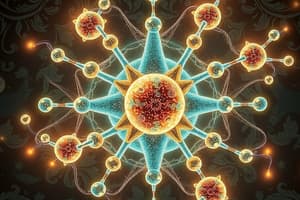Podcast
Questions and Answers
Covalent bonds hold atoms together because they...
Covalent bonds hold atoms together because they...
- Create larger atomic nuclei
- Fill shells without giving atoms much charge (correct)
- Bring electrons closer to protons
- Cause atoms to lose electrons
In molecules, C, H, O and N atoms usually make __, ___, ____, and ___ bonds respectively.
In molecules, C, H, O and N atoms usually make __, ___, ____, and ___ bonds respectively.
4, 1, 2, 3
An atom's atomic number is 7. Its valence is most likely...
An atom's atomic number is 7. Its valence is most likely...
3
By making two covalent bonds, an O atom (with 8 protons) fills its valence shell. Why does the atom's charge stay close to zero?
By making two covalent bonds, an O atom (with 8 protons) fills its valence shell. Why does the atom's charge stay close to zero?
In a double covalent bond, a carbon atom shares...
In a double covalent bond, a carbon atom shares...
The ammonia molecule has the observed bond orientation because...
The ammonia molecule has the observed bond orientation because...
Without making or breaking bonds, the pictured molecule can change its shape because...
Without making or breaking bonds, the pictured molecule can change its shape because...
Two C atoms form a double bond. Each C is bound to two H atoms. All the atoms lie in a plane.
Two C atoms form a double bond. Each C is bound to two H atoms. All the atoms lie in a plane.
Partial charges occur when...
Partial charges occur when...
To fill the valence shell, an electrically neutral, unbonded atom with atomic number 8 must add...
To fill the valence shell, an electrically neutral, unbonded atom with atomic number 8 must add...
Flashcards are hidden until you start studying
Study Notes
Covalent Bonds
- Covalent bonds hold atoms together by filling electron shells without significantly charging the atoms.
- These bonds help bring electrons closer to protons, stabilizing the molecule.
Bonding Characteristics of Atoms
- Carbon (C) typically forms four bonds, hydrogen (H) forms one bond, oxygen (O) forms two bonds, and nitrogen (N) forms three bonds.
Valence and Atomic Number
- An atom with an atomic number of 7 is likely to have a valence of 3, indicating its bonding potential.
Oxygen's Charge Neutrality
- Oxygen can fill its valence shell by forming two covalent bonds, yet its overall charge remains close to zero because shared electrons are not always located near the oxygen nucleus.
Double Covalent Bonds
- In a double covalent bond, a carbon atom shares electrons residing in two orbitals, enhancing stability.
Ammonia Molecular Structure
- The ammonia molecule has a specific bond orientation due to nitrogen having four electron pairs; these pairs repel each other, influencing molecular shape.
Molecular Shape Flexibility
- Molecules can alter shape without forming or breaking bonds because rotation is permissible around single bonds.
Double Bond Characteristics
- In a molecule where two carbon atoms form a double bond and each carbon is bound to two hydrogen atoms, all the atoms lie in the same plane, indicating a fixed geometry.
Partial Charges in Covalent Bonds
- Partial charges arise when covalent bonds connect atoms of differing types, leading to unequal sharing of electrons.
Valence Shell Filling for Neutral Atoms
- A neutral, unbonded atom with an atomic number of 8 must acquire 2 additional electrons to completely fill its valence shell.
Studying That Suits You
Use AI to generate personalized quizzes and flashcards to suit your learning preferences.




